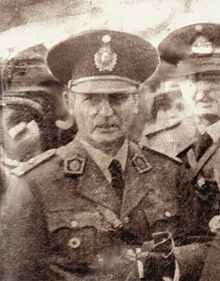Arturo Rawson
This article needs additional citations for verification. (January 2013) |
Arturo Rawson | |
|---|---|
 | |
| President of Argentina | |
| In office June 4, 1943 – June 6, 1943 | |
| Appointed by | Military junta |
| Vice President | None |
| Preceded by | Ramón Castillo |
| Succeeded by | Pedro Pablo Ramírez (de facto) |
| Personal details | |
| Born | June 4, 1885 Santiago del Estero |
| Died | October 8, 1952 (aged 67) Buenos Aires |
| Nationality | Argentine |
| Political party | Independent |
| Spouse | Delia Sixta Borda (1895–1983) |
| Profession | Military |
Arturo Rawson (June 4, 1885 – October 8, 1952) was an
His coup started a series which culminated in the accession to power of the
Biography
Rawson was born in
Rawson promptly declared himself president of Argentina the same day, beating Pedro Pablo Ramírez to do so.[6] However, his choices for his cabinet alienated the GOU leadership, who forced him to resign on June 7. Rawson, as Castillo did, supported the Allies of World War II, but the bulk of the military that organized the coup wanted Argentina to stay neutral in the conflict, considering that joining the war would prove destructive for the country. Colonel Elbio Anaya appeared at his office and told him that he was ruling because of a misunderstanding, as the president was Ramírez. Rawson resigned, and rejected the military escort, leaving the Casa Rosada on a military jeep. His time as president was so brief that he never actually made the Oath of office. Even so, he did not take power as an interim president, but expecting to rule for a long time.[7] Thus, Rawson has had the second shortest mandate of any Argentine president, and the shortest mandate of any Argentine non-acting president, holding the office for just three days (the first being Federico Pinedo with 12 hours).[6]
After resigning as president, Rawson was appointed
See also
Bibliography
- ISBN 978-987-627-166-0.
References
- ^ "Argentina | History, Facts, Map, & Culture". Encyclopedia Britannica. Retrieved 2018-08-18.
- ^ "Biografia de Arturo Rawson". 2016-03-04. Archived from the original on 2016-03-04. Retrieved 2018-08-18.
- ^ a b c TheBiography.us. "Biography of Arturo Rawson (1884-1952)". Archived from the original on 2018-08-18. Retrieved 2018-08-18.
- ^ "Biografia de Arturo Rawson". www.biografiasyvidas.com (in Spanish). Retrieved 2018-08-18.
- ^ "Amán Rawson Hull b. 1794 Montague, MA, Estados Unidos d. 11 Jan 1847 San Juan, San Juan, Argentina: Genealogía Familiar". 2015-10-03. Archived from the original on 2015-10-03. Retrieved 2018-08-18.
- ^ a b Mendelevich, p. 144
- ^ Mendelevich, p. 145
- ^ Mendelevich, p. 146

